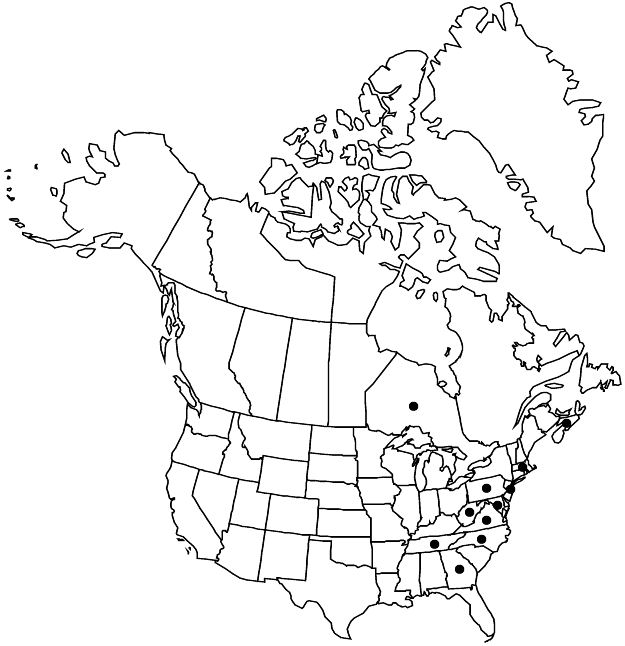Difference between revisions of "Spiraea corymbosa"
Précis Découv. Somiol., 36. 1814.
FNA>Volume Importer |
FNA>Volume Importer |
||
| Line 16: | Line 16: | ||
|name=Spiraea betulifolia var. corymbosa | |name=Spiraea betulifolia var. corymbosa | ||
|authority=(Rafinesque) S. Watson | |authority=(Rafinesque) S. Watson | ||
| − | }}{{Treatment/ID/Synonym | + | }} {{Treatment/ID/Synonym |
|name=S. ostryfolia | |name=S. ostryfolia | ||
|authority=Rafinesque | |authority=Rafinesque | ||
| − | }}{{Treatment/ID/Synonym | + | }} {{Treatment/ID/Synonym |
|name=S. repens | |name=S. repens | ||
|authority=Rafinesque | |authority=Rafinesque | ||
| − | }}{{Treatment/ID/Synonym | + | }} {{Treatment/ID/Synonym |
|name=S. sororia | |name=S. sororia | ||
|authority=Penny ex G. Don | |authority=Penny ex G. Don | ||
| Line 40: | Line 40: | ||
|elevation=0–500 m | |elevation=0–500 m | ||
|distribution=N.S.;Ont.;Ga.;Md.;Mass.;N.J.;N.C.;Pa.;Tenn.;Va.;W.Va.;introduced in e Europe. | |distribution=N.S.;Ont.;Ga.;Md.;Mass.;N.J.;N.C.;Pa.;Tenn.;Va.;W.Va.;introduced in e Europe. | ||
| − | |discussion=<p>H. A. Gleason and A. Cronquist (1963) and L. J. Uttal (1974) considered Spiraea corymbosa to be a variety of S. betulifolia. K. Sax (1936) found S. corymbosa to be a triploid with complete pollen sterility and hypothesized that it must exist as a diploid, or form viable egg cells, because it is involved in hybrids. If so, these cytological differences may be correlated with some morphological variation.</p> | + | |discussion=<p>H. A. Gleason and A. Cronquist (1963) and L. J. Uttal (1974) considered <i>Spiraea corymbosa</i> to be a variety of S. betulifolia. K. Sax (1936) found <i>S. corymbosa</i> to be a triploid with complete pollen sterility and hypothesized that it must exist as a diploid, or form viable egg cells, because it is involved in hybrids. If so, these cytological differences may be correlated with some morphological variation.</p> |
|tables= | |tables= | ||
|references= | |references= | ||
| Line 64: | Line 64: | ||
|publication year=1814 | |publication year=1814 | ||
|special status=Endemic | |special status=Endemic | ||
| − | |source xml=https://jpend@bitbucket.org/aafc-mbb/fna-data-curation.git/src/ | + | |source xml=https://jpend@bitbucket.org/aafc-mbb/fna-data-curation.git/src/8f726806613d60c220dc4493de13607dd3150896/coarse_grained_fna_xml/V9/V9_675.xml |
|subfamily=Rosaceae subfam. Amygdaloideae | |subfamily=Rosaceae subfam. Amygdaloideae | ||
|tribe=Rosaceae tribe Spiraeeae | |tribe=Rosaceae tribe Spiraeeae | ||
Revision as of 18:18, 18 September 2019
Shrubs, 3–10(–15) dm. Stems erect to arching, branched. Leaves: petiole 3–8 mm, sparsely hairy; blade ovate to elliptic or suborbiculate, 2–10 × 1–2.5 cm, coriaceous, base obtuse, rounded, or subcordate, margins irregularly, coarsely and sharply doubly serrate from midpoint to apex, teeth acute and mucronate, number of primary and secondary serrations 1 times number of secondary veins (excluding inter-secondary veins), venation pinnate cladodromous, secondary veins not prominent, apex acute, obtuse, or rounded, abaxial surface mostly glabrous, adaxial glabrous. Inflorescences mostly terminal, corymbiform, 2–5 × 3–10 cm height 0.4–1.1 times diam.; branches rarely in axils of leaves, glabrous or glabrate. Pedicels 1–3 mm, glabrous or glabrate. Flowers 4–7 mm diam.; hypanthia hemispheric, 0.8–1 mm, abaxial surface glabrous or pubescent, adaxial glabrous; sepals triangular, 0.5–1 mm; petals chalky white to pink, orbiculate, 1.3–1.5 mm; staminodes 5–15 reduced to serrations; stamens 15–20, 2 times petal length. Follicles nearly fusiform, 2–3 mm, shiny, glabrous. 2n = 36.
Phenology: Flowering May–Oct; fruiting Jun–Nov.
Habitat: Open rocky soil, rocky, lightly wooded sites, dry or fast draining slopes, rocky edges of woods
Elevation: 0–500 m
Distribution

N.S., Ont., Ga., Md., Mass., N.J., N.C., Pa., Tenn., Va., W.Va., introduced in e Europe.
Discussion
H. A. Gleason and A. Cronquist (1963) and L. J. Uttal (1974) considered Spiraea corymbosa to be a variety of S. betulifolia. K. Sax (1936) found S. corymbosa to be a triploid with complete pollen sterility and hypothesized that it must exist as a diploid, or form viable egg cells, because it is involved in hybrids. If so, these cytological differences may be correlated with some morphological variation.
Selected References
None.